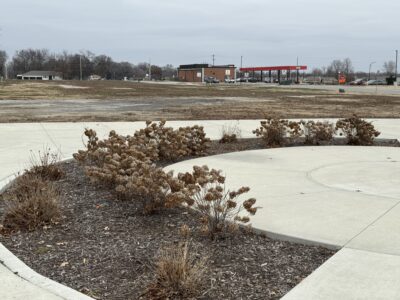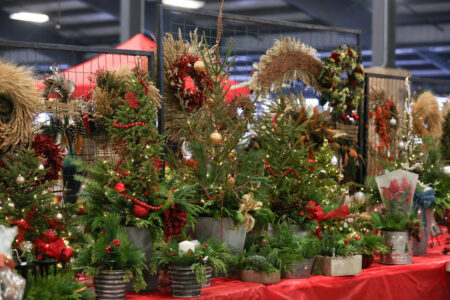For Van Go’s youth artists, ‘Benchmark’ process is more than just painting benches

photo by: Austin Hornbostel/Journal-World
Artists with arts-based social service nonprofit Van Go's JAMS employment program work on custom-designed benches Thursday, July 6, 2023. The benches being created as part of Van Go's "Benchmark" program will be unveiled later this month.
When arts-based social service nonprofit Van Go unveils the custom benches created by its apprentice artists as part of its “Benchmark” program each summer, it typically doesn’t have any trouble drawing a crowd. But few of those folks are lucky enough to get a peek behind the curtain to see the weeks of work it’s taken to get to that point.
Year after year, youths ages 14 to 18 who are employed through Van Go’s JAMS program partner with a client in the community to design and produce a custom bench. To date, Van Go artists have created hundreds of them, and the latest crop will add roughly 20 more works of art to that list.
Van Go artists are currently in the thick of their work on this year’s set of benches, with about three weeks remaining until their unveiling on Friday, July 28, at 5:30 p.m. at Van Go, 715 New Jersey St. The Journal-World tagged along Thursday as Van Go artists continued that work, led by three leaders on the JAMS staff: Davon Davis, Cornelio Ortega-Perez and LeStat Wilson.
The trio are recent high school grads and each has participated in Benchmark before. This is the second time for Wilson and the third for both Davis and Ortega-Perez. Because they’re so experienced, they’re all team leaders — artists who serve in an additional leadership role and as a resource for a group of four or five of their peers.
“… Team leaders, especially, (it helps) knowing that there’s someone they can go to and ask for help,” Davis said. “We’re like pretty relatively close in age, so I think (sometimes it’s easier to ask) someone who’s as old as you for help.”
And even though each JAMS employee has their own bench to worry about, Van Go co-director Kristen Malloy said there’s still teamwork in their work environment. The idea that they’re all responsible for their own projects is just as important as the idea that, as a group, they’re also responsible for helping each other collectively move the needle of progress.
“Overall, it feels good to help somebody, especially when they’re depending on you,” Wilson added.
• • •
In Van Go’s artist work space, there’s a poster hanging on one wall that serves as a progress marker for each JAMS artist. It lists nearly 20 tasks that serve as milestones along the path to finishing a bench, like client meetings and the different steps of the design and painting process. Each artist fills in squares that correspond to the tasks as they go.
The poster is a visual representation of how far each artist has come on their individual creative process — and an additional reminder of the work yet to be done.
At the start of the eight-week session, the first few days usually consist of Van Go artists learning who their clients are and drawing “thumbnail” sketches of their bench ideas. There are a number of steps on the poster that get knocked out in those early days, and from there work begins on pieces of the process like painting a blueprint — the full-scale design that will eventually go on a finished bench, just on paper.
Each artist is at a different point in that process right now, and just about all of them have made it through about half of the steps on the progress poster. Wilson, for example, on Thursday was working to finish the base coat of paint on her bench. Once that’s done, she can move on to incorporating the details, some of which have been subject to some tweaks lately.
The Benchmark process doesn’t just consist of designing and painting the bench itself — learning to work one-on-one with a client is also a key part of the job training program. Wilson’s piece, for example, was commissioned as a memorial bench for her client’s family members, and she’s now met with that client to get their feedback. That back and forth has been a “smooth ride” so far, Wilson said.
“It’s an honor to do a memorial bench, in my case,” Wilson said. “Especially when I’m able to honor the family members by making a bench … Sometimes feelings and tears — even sometimes tears of happiness or sadness — will come out, and when you see those it means a lot. It helps us to know how much this bench really means to a person.”

photo by: Austin Hornbostel/Journal-World
JAMS artist LeStat Wilson works to apply the base coat of paint to her bench.
Ortega-Perez, meanwhile, is working on something of a collaborative project. He and another member of his team are both crafting benches meant to honor Pinckney Elementary School, which was shuttered at the end of the last school year due to budget cuts after operating in the same general location for nearly 170 years. Their benches will be placed at Hillcrest and Deerfield elementaries, the schools that most Pinckney students will transfer to as a result of the school boundary changes related to the closure.
That means the two artists are aiming to incorporate similar elements into their separate works, such as nods to the Pinckney Tunnel mural Van Go artists created in 2013, and imagery corresponding to the specific school each bench will be sent to.

photo by: Austin Hornbostel/Journal-World
JAMS artist Cornelio Ortega-Perez, right, works on his bench — part of a pair dedicated to Pinckney Elementary School.
“I’m going to implement more Pinckney stuff because there was this hide-and-seek element within the tunnel (mural) of panthers and trying to find them,” Ortega-Perez said. “I think adding that to my bench is going to just give (former students) a bigger reminder of how important Pinckney was in general, and show them that Pinckney’s not really gone — it’s still a part of them. I think that’s a special thing for children who went to that school.”
The collaboration is an “ambitious” idea, so Ortega-Perez said that’s meant the process has taken a bit longer to hash out. But the artists actually came up with the idea themselves, Malloy added, as a way to help provide some closure to families who are still reckoning with the emotional impact of the school’s closure.
“It’s amazing every year the bench clients who come to the table and believe in our program and believe in our youth and believe in the work that they do here and that we do here, and the things that they entrust in them,” Malloy said.
Davis is also working on a pretty special bench for this year’s program — it’ll be the first Benchmark piece to go international. His client will be sending the bench to Mexico City once it’s completed as a gift to another company.
But even though he’ll be the first artist whose work will leave the country, Davis said there haven’t been any major surprises in the process this time around. In fact, he’s feeling confident thanks to his past Benchmark experience.
“The only different thing in my process now is that I have more skills, and I’ve gotten better,” Davis said.
For Davis, the process of working with his client has also led to some changes to his design that he’s now working to incorporate. His next steps are similar to Wilson’s — finishing his base coat and blocking and then moving on to the details.

photo by: Austin Hornbostel/Journal-World
JAMS artist Davon Davis, with help from Van Go co-directors Eliza Darmon and Kristen Malloy, holds up the blueprint for his bench.
• • •
For Wilson, Davis and Ortega-Perez, this is the last time they’ll be able to create a piece for Benchmark since they’ll have aged out of JAMS eligibility by next summer. But all three of them are looking ahead to what’s next. Davis said he might continue with the arts and has plans to become an auto mechanic, and Ortega-Perez said he aims to pursue culinary arts at Johnson County Community College. Wilson, with the help of Van Go, is currently enrolled in a welding certification course at Peaslee Tech.
Those aspirations are possible, in part, because of Van Go’s impact on the trio. Wilson and Davis started in the nonprofit’s Pre-Employment Prep Program, a product of the coronavirus pandemic, and found a “refreshing” place where they could connect with other kids during a time that was increasingly isolating for high school students across the country.
And for Wilson, Van Go quickly became a place she could call home.
“The first day that I came in here, I was really nervous and I didn’t really know anybody,” Wilson said. “Over the session, over the few weeks that we had, I started to really feel like I belonged here and like I had a place here.”







